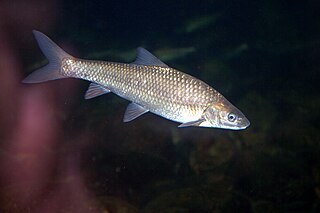
John Treadwell Nichols was an American ichthyologist and ornithologist.

The greenstripe barb, silver barb or striped barb is a tropical freshwater and brackish ray-finned fish belonging to the family Cyprinidae, the family which includes the carps, barbs and related fishes. This species is found in South Asia. It is the only species in the monospecific genus Bhava.

The White River springfish is a species of fish in the family Goodeidae, the splitfins. It is a rare species of the Great Basin of western United States, where it is endemic to isolated warm springs in the White River drainage of eastern Nevada.
George Sprague Myers was an American ichthyologist who spent most of his career at Stanford University. He served as the editor of Stanford Ichthyological Bulletin as well as president of the American Society of Ichthyologists and Herpetologists. Myers was also head of the Division of Fishes at the United States National Museum, and held a position as an ichthyologist for the United States Fish and Wildlife Service. He was also an advisor in fisheries and ichthyology to the Brazilian Government.
The resplendent pygmy angelfish is a species of marine ray-finned fish, a marine angelfish, belonging to the family Pomacanthidae. It is endemic to Ascension Island in the South Atlantic Ocean.

Cilus is a monospecific genus of marine ray-finned fish belonging to the family Sciaenidae, the croakers and drums. Its only species is Cilus gilberti, the corvina or corvina drum, which is found mostly tropical to temperate coastal waters of the southeastern Pacific along Central and South America. The corvina is highly prized in South America as a food fish.
Hemiculter krempfi is a species of ray-finned fish in the genus Hemiculter. It is known only from the Cai River in Khanh Hoa Province and the Da Rang River in Phu Yen Province of central Vietnam. Here it is found mainly over sand substrates and is infrequently encountered in fish markets.

Genyomyrus is a monospecific genus of freshwater fish belonging to the family Mormyridae, the elephantfishes. The only species in the genus is Genyomyrus donnyi which is endemic to the Congo River. It reaches a length of about 45 cm (1.5 ft).
Isischthys is a monospecific genus of freshwater ray-finned fish belonging to the family Mormyridae, the elephantfishes. The only species in the genus is Isichthys henryi. It occurs in coastal river basins in West Africa, ranging as far southeast as the Kouilou-Niari River in Middle Africa. It reaches a length of about 29 cm (11 in).

Chagunius is a genus of freshwater ray-finned fish belonging to the family Cyprinidae. which includes the carps, barbs and related fishes. The fishes in this genus occur in South and Southeast Asia.

The scalyhead triplefin is a species of triplefin blenny in the genus Norfolkia. It was described by Allan Riverstone McCulloch and Edgar Ravenswood Waite in 1916. Under the synonym Norfolkia lairdi it was the type species of Fowler's new genus. This species has been recorded from off Queensland, Norfolk Island, Lord Howe Island, New Caledonia and the Loyalty Islands. The adults occur in tidal pools among areas of coral reef.
The Mexican rivulus is a species of killifish from the family Rivulidae which is endemic to Mexico where it is found in the Papaloapan and Coatzacoalcos River basins. This annual killifish grows to a total length of 4 cm (1.6 in). It is the only known species in its genus, but its exact taxonomic position remains uncertain, as it has not been included in any phylogenetic study. This species was described by Robert Rush Miller and Carl Leavitt Hubbs as Rivulus robustus in 1974, it was reclassified in the monotypic genus Millerichthys in 1995, the generic name honouring Robert Rush Miller.
The black sculpin is a species of freshawater ray-finned fish belonging to the family Cottidae, the typical sculpins. It is endemic to the United States. Its range includes the extreme upper Clinch and Holston River systems in western Virginia and just into northeastern Tennessee. It reaches a maximum length of 8 cm (3.1 in).
Schizopygopsis eckloni is a species of freshwater ray-finned fish belonging to the family Cyprinidae, the family which also includes the carps, barbs, minnowns and related fishes. This fish is endemic to China where it occurs in the upper Yellow River drainage, from Qinghai to Gansu and parts of Sichuan. This species has maximum published standard length of 39.5 cm (15.6 in).
Schizopygopsis potanini is a species of freshwater ray-finned fish belonging to the family Cyprinidae, the family which also includes the carps, barbs, minnowns and related fishes. This fish is endemic to China where it is restricted to Sichuan in the upper reaches of the Minjiang River, a tributary of the Changjiang where it inhabits cool, montaine rivers.

Chagunius chagunio, the chaguni, is a species of cyprinid in the genus Chagunius. It inhabits wetlands in Bangladesh, India, Nepal and Bhutan.

Chagunius nicholsi is a species of cyprinid in the genus Chagunius that inhabits India and Myanmar. It inhabits India and Myanmar. Its maximum length is 30 cm, and its maximum published weight is 900 g (1.98 lbs). Its habitat is inland wetlands. The specific name of this fish honours the American zoologist John Treadwell Nichols of the American Museum of Natural History who helped Myers with his work.
Hypoptopoma baileyi is a species of catfish of the family Loricariidae.
Percocypris tchangi is a species of freshwater ray-finned fish belonging to the family Cyprinidae, the family which also includes the carps, barbs, minnowns and related fishes. It is found in the Salween and Mekong basins of Vietnam.

Cheilobarbus, commonly known as sawfins, is a small genus of freshwater ray-finned fishes belonging to the family Cyprinidae, the family which includes the carps, barbs and related fishes. The fishes in this genus are endemic to the Western Cape of South Africa.








